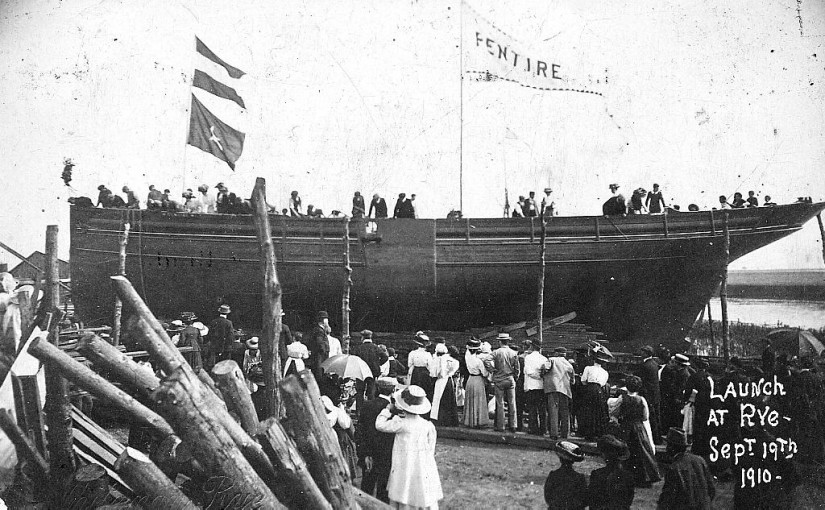The Sara Colebrooke Saga
By Tony Bridgland
Browsing through your June 2004 issue whilst in the doctor’s waiting-room, I came across two separate articles which dovetailed together to be of particular interest to me. One was “The Amazing Story of a Rye Shipyard” and the other, by Arthur Woodgate, told how the coaster ‘Sara Colebrooke’ was launched at Rock Channel on the day that he was born.
The 158 ton ketch-rigged ‘Sara Colebrooke’ was named after the wife of W.E. Colebrooke, a prominent Rye businessman. The family name will be familiar to many older readers. She was no ordinary coaster. Her life was to be filled with controversy, right from the day of her intended launch in 1912 (?), when she became stuck on the slipway and refused to enter the water. They managed to coax her afloat the next day. This was related by an old Ryer (whose name I have lost, unfortunately, but whose letter can be found in the Imperial War Museum archives), who remembered as a schoolboy being always given time off from lessons to watch the launching of a Rye boat. He was very grateful to the ‘Sara Colebrooke’ for the double free time she gave him.
Her early life was spent humping coal down from Newcastle, in company with countless others of her hard working breed, crewed by Alf Woods and ‘Winky’ Smith.
Then came World War One. The German U-boat fleet was sinking hundreds of thousands of tons of the merchant ships bringing vital food and supplies to Great Britain. The situation was dire. The Admiralty decided to counter this by taking over harmless looking freighters of all sizes, right down to tiny fishing smacks, arm them with concealed guns manned by hidden Royal Navy gun crews and setting them to lure U-boats into point blank range before revealing themselves for what they were, lethal decoys, and blow the submarine out of the water. They called them Q-ships and the crew of a Q-ship required special courage.
In May 1917, the Navy requisitioned the ‘Sara Colebrooke’ and commissioned her at Portsmouth as a Q-ship with the name HMS Bolham. They gave her two 3-inch high velocity guns, depth-charges, machine guns and a lot of ammunition. They packed sandbags inside her and reinforced her Leeboards with steel plates. Lieutenant C.W.Walters, RNR, was placed in command, with three officers, three engineers, two wireless operators, three petty officers and a bluejacket crew. Walters said that she was the ‘queerest’ craft he had ever handled, but was proud to claim that his gunners could load, train and fire her 3-inch guns within FIVE seconds.
From July 2005 Issue of “Rye’s Own”
